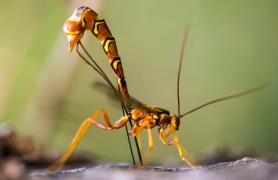Body
- Have you ever found a tick in your hair? Gross, right? Well, when an opossum finds a tick in its fur, the scruffy mammal eats the bloodsucker. In fact, a single opossum may snarf down nearly 4,000 ticks in a week!
- Don’t say you weren’t warned. Before unleashing its funky fury, a spotted skunk often stomps its front paws, flips up into a handstand, and walks around with its tail held high like a furry, black danger flag.
- Hey, four-eyes! A Whirligig beetle has four large compound eyes — two on top of its head and two underneath. The top set watches for danger up above, while the bottom set peers underwater, looking for lunch.
- Pigeons have an uncanny ability to find their way home. Biologists believe the often-seen birds can feel the Earth’s magnetic field. Pigeons may also track the sun’s position and follow familiar smells and sounds to find their way.
- Pip, pip, hooray! When hatching, a baby bird pips (breaks open) the shell of its egg using a hornlike knob at the end of its beak called an egg tooth. The tooth disappears shortly after the hatchling breaks free.
- Striped bass normally live in salt water along the Atlantic and Pacific coasts. But the large, tasty fish seem to do fine in fresh water, too. They were stocked in Missouri lakes starting in the 1960s and have thrived in the Show-Me State ever since.
- The pygmy rattlesnake wins the prize for being Missouri’s smallest venomous snake. The tiny viper rarely grows larger than 20 inches long. The noise made by its itsy-bitsy rattles sounds like a bee buzzing and can be heard only a few feet away.
Also In This Issue
Media

Body
Meet Nop. He’s here to teach you how to take awesome nature photos.
Media

Body
Five wasps to Xplor (and one to watch out for).
This Issue's Staff
Bonnie Chasteen
Les Fortenberry
Karen Hudson
Angie Daly Morfeld
Noppadol Paothong
Marci Porter
Mark Raithel
Laura Scheuler
Matt Seek
David Stonner
Nichole LeClair Terrill
Stephanie Thurber
Cliff White
Les Fortenberry
Karen Hudson
Angie Daly Morfeld
Noppadol Paothong
Marci Porter
Mark Raithel
Laura Scheuler
Matt Seek
David Stonner
Nichole LeClair Terrill
Stephanie Thurber
Cliff White






















